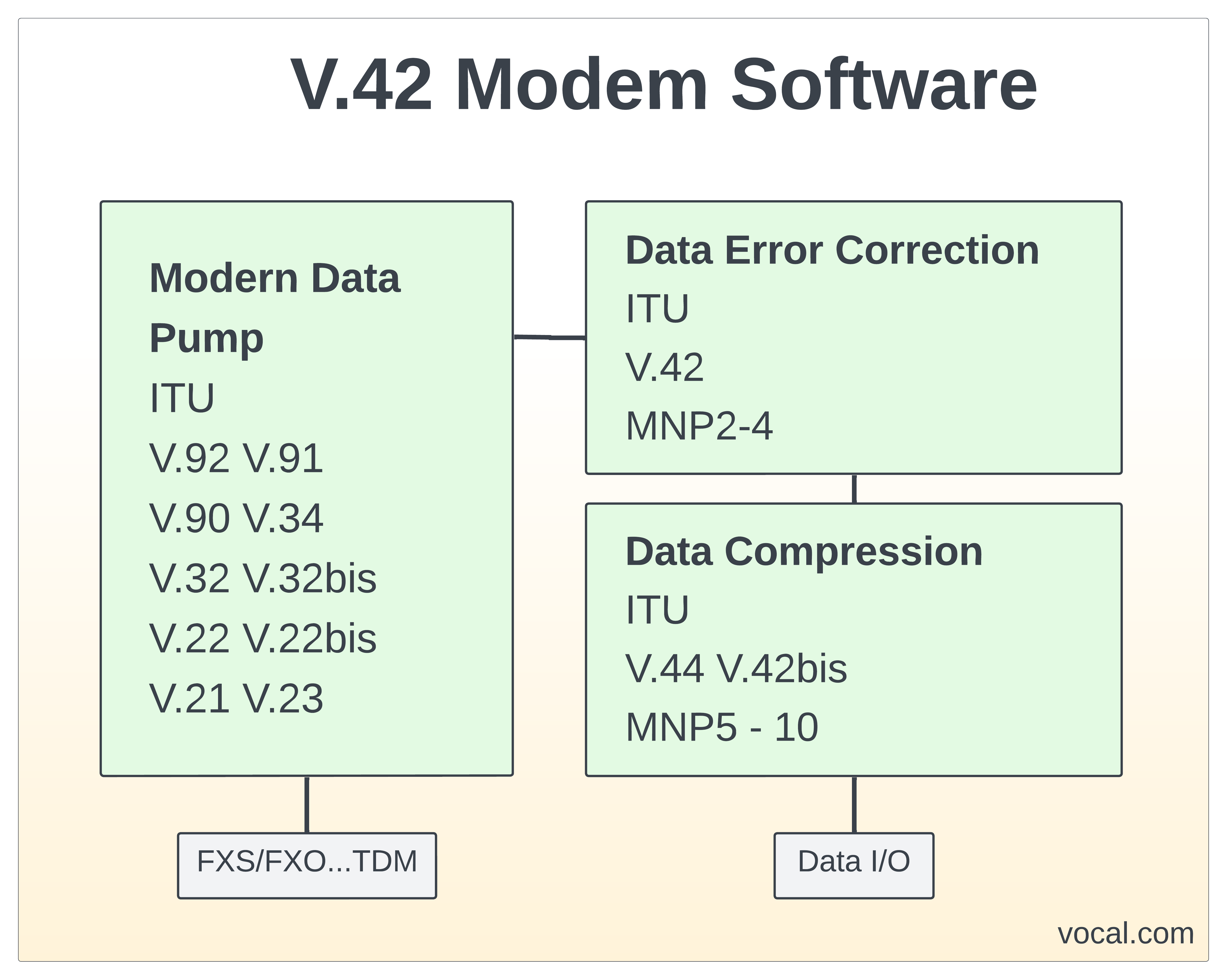 V.42 / V.42bis software implements the ITU-T V.42 error correction protocols including MNP2-4, MNP5, and MNP10 data protocols. In addition, both LAPM (Link Access Procedure for Modems) and an alternate protocol are supported. The alternate, as described by V.42, is the MNP (Microcom Networking Protocol) data protocol, classes 2 through 4. LAPM and MNP2-4 implement end-to-end error correction through an automatic repeat-transmission request algorithm. Contact us to discuss your modem application requirements.
V.42 / V.42bis software implements the ITU-T V.42 error correction protocols including MNP2-4, MNP5, and MNP10 data protocols. In addition, both LAPM (Link Access Procedure for Modems) and an alternate protocol are supported. The alternate, as described by V.42, is the MNP (Microcom Networking Protocol) data protocol, classes 2 through 4. LAPM and MNP2-4 implement end-to-end error correction through an automatic repeat-transmission request algorithm. Contact us to discuss your modem application requirements.
Virtual Modem over IP
VOCAL’s SIP Software modem (MoIP or V.MoIP) solution provides developers a range of solutions to connect legacy dial up modems to modem infrastructure. Unlike other virtual modem designs, the SIP software modem can communicate with a physical modem at the far end using a VoIP service over an IP network.
VOCAL’s V.42 / V.42bis modem software is optimized for performance on leading DSP architectures and processors from TI, Intel, ADI, AMD and other vendors. Our V.42 software may be licensed standalone, as a library or part of complete design. Custom solutions are also available.
V.42 and V.42bis Software Features
- Modem MIB Support (RFC 1696)
- Extended Buffered Mode Support for V.80 features
- Extended Buffered Mode Supports V.110 rate adaptation
- Extended Buffered Mode Supports PPP Framing (RFC 1662)
- Detection Phase
- Automatic LAPM detection
- MNP autoreliable mode
- Buffered Mode (Speed Matching) provides modem-to-modem flow control
- Direct Mode support
- Extended Buffered Mode Support for V.80 features
- V.42bis compression: provides up to 4:1 compression
- MNP5 compression: provides up to 2:1 compression
- Multi-tasking environment compatible
V.42bis and MNP 5 Data Compression
VOCAL’s modem protocols provide software developers a compression capability with ITU-T V.42bis and MNP5 algorithms. The V.42bis data compression protocol is sometimes used standalone. Classically, V.42bis has been used with LAPM and MNP5 is used with classes 2-4.
MNP2-4 / MNP 5 / MNP 10 Data Protocols
MNP2 is an error correction algorithm using data packets of asynchronous characters over a full-duplex modulation while MNP3 introduced the use of HDLC based synchronous packets. MNP4 can be used with or without the class 3 protocol feature; it provides for the use of slightly smaller (through optimized headers) data and acknowledge packets.
Configuration
- VOCAL’s Overall Modem Controller (OMC) Layer provides coordinated data modulation/protocol operation relative to startup, shutdown, modulation retrains and modulation renegotiations.
- V.14/HDLC/Binary/FSK SART layer support for buffered mode
- V.14/FSK SART layer support for asynchronous MNP mode
- HDLC SART layer support for LAPM, synchronous MNP modes
- V.42 support for ADP/ODP generation/detection, automatic protocol detection mechanisms
- System configuration supports the overlay of LAPM, MNP 2-4, Buffered and Direct Modes for maximum program and memory efficiency.
- System configuration supports the overlay of V.42bis and MNP5 for maximum program and data memory efficiency.
- System configuration supports the overlay of data protocols with fax protocols for maximum program and data memory efficiency.
- System configuration supports compile-time selectable V.42bis dictionary size and string size.
- VOCAL’s OMC Layer can be used standalone in a non command-set environment (although a variety of commands sets are available from VOCAL)
- Compatible with ITU and Bell data modulations through V.90 (also available from VOCAL).
More Information
- Data Modem
- 56K Modem Software
- Data Modulation Software
- Data Protocol Software
- Command Set Controller Software
- V.22bis / V.22 / Bell 212 / V.23 / V.21 / Bell 103 Modem Software
- V.32bis and V.32 Modem Software
- V.34 Modem Software
- V.44 Data Compression Software
- V.90 Modem Software
- V.91 Modem Software
- V.92 Modem Software
- V.92 Modem-on-Hold, PCM upstream and Quick Connect Features
VOCAL’s optimized software is available for the above platforms. Please contact us for specific V.42 and V.42bis supported platforms.